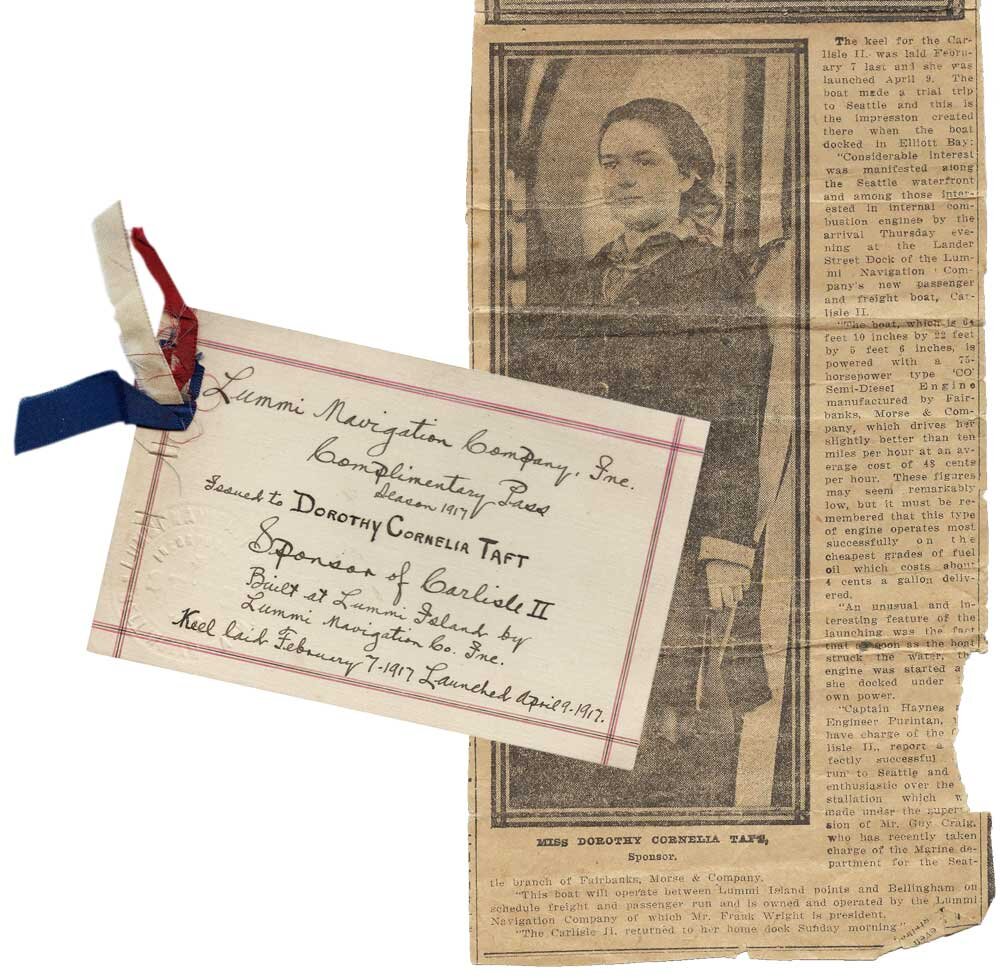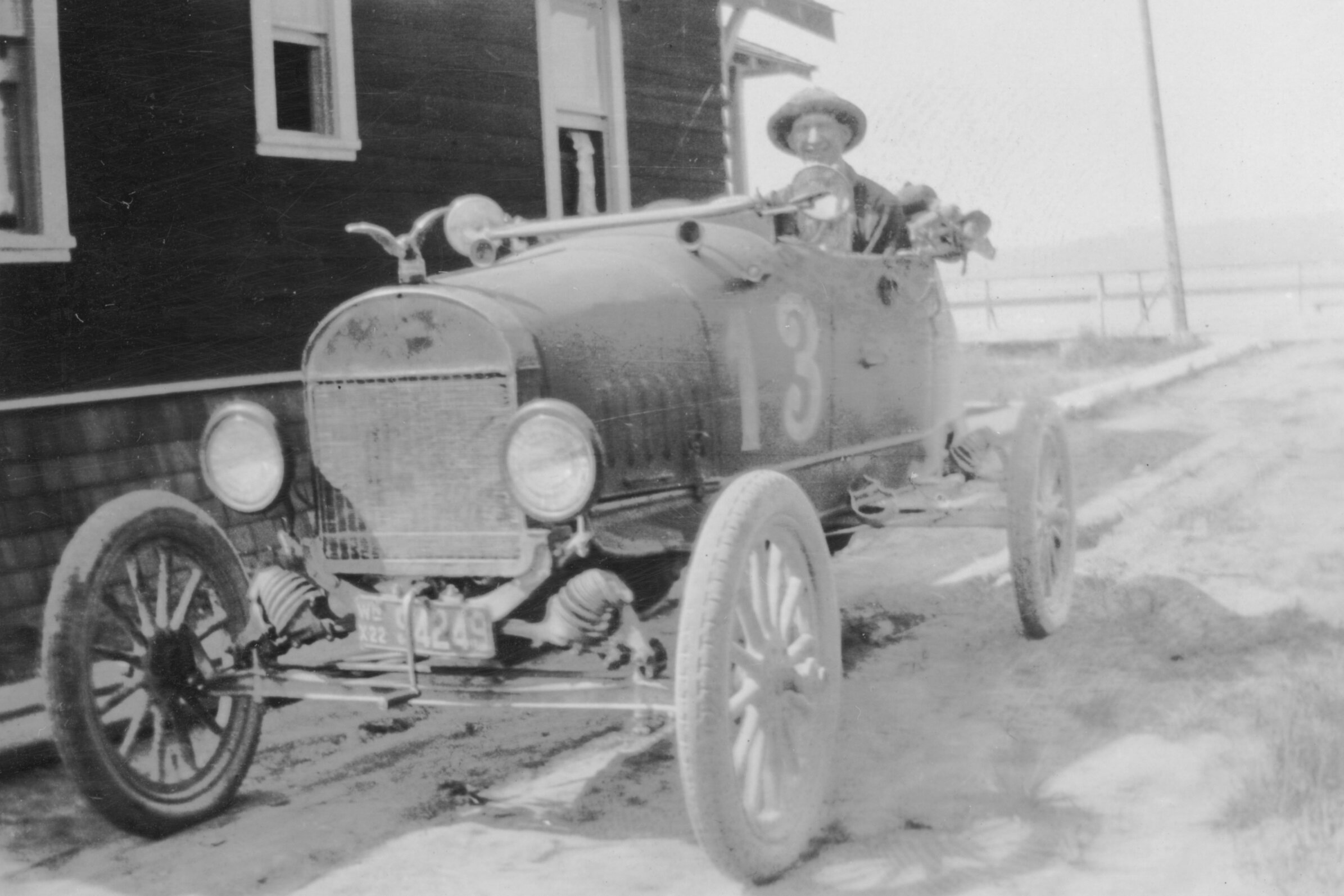Euno who? Lost love at The Willows
/Euno’s June 1921 letter, with The Willows business card and envelope.
Source: Washington Rural Heritage
A flirtatious correspondence in the heat of summer from a woman of mystery. The Lost Generation was just swinging into the Roaring Twenties with a Lummi Island intrigue that carries on a century later. It started with a business card...
Dear Gee Aye Em, How about it?
A century before bubbly young brand partners commercialised social media, H.E.M. was working her network on behalf of Frank and Ruby Taft and their resort on Lummi Island. Frank was a gifted promoter and knew how to get nationwide press attention for the “quiet haven” at Taft’s The Willows. A few business cards in the envelope of a coquette was just the kind of guerrilla marketing he needed to reach young trendsetters as well.
George Munro and friends, with George carrying his cheer horn.
Photo courtesy of the Munro family.
Gee Aye Em was George Alexander Munro of Bainbridge Island, 21—a handsome redhead and subject of her chase. He was the sixth of 10 children and worked as an electrician at the Puget Sound Naval Shipyard in Bremerton. His father, Alexander, was a Scottish stonemason and about to start work on the State Capitol in Olympia as lead stone cutter.
Dear Gee Aye Em,
How about it? Mr. Taft just sent me some of his business cards (see enclosed one) and told me to do some missionary work among my friends. It looks as tho I really could go there for a week in August. But I don't know which week. Here's hoping!
Euno.
Euno… A clue for her middle initial, nickname for Eunice, or just an inside joke from you know who? The envelope was posted from Seattle, probably where H.E.M. lived. The business card was confident and minimal, “an Exclusive Resort for Your Vacation” with the name of Mrs. Frank M. Taft. Phone numbers and street addresses were a thing of the future for The Willows.
Laddie Dear, Speaking of carrots
The envelope postmarked August 27, 1921.
It was now late August and George was confirmed for arrival. H.E.M. was already at The Willows, scripting in green ink with an unabashed zest worthy of Zelda Fitzgerald. F. Scott’s This Side of Paradise had only been published a year before and the Fitzgeralds were immediate celebrities, the personification of the Jazz Age. For the first time American youth had their own rebellious slang, music, and morality—a collective shiver to shake off the ashes of the Great War and pandemic.
Each following generation has had its own brand of revolution, but it started with the fellas and flappers.
Laddie Dear,
Speaking of carrots (and carrot-tops) I thought I'd better answer, and tell you how elated I was that you were arriving! Your letter was the cleverest thing I ever saw, but almost gave me the Bainbridge blues for Red. Pop Taft will meet the Carlisle II at Beach and bring you to the Willows.
H.E.M.’s self portrait sketched into her letter.
While the gushing subtext is an endless delight, H.E.M. is simultaneously documenting details that have washed under a century of time. Thankfully some of the pieces are still around, just in different places.
Carlisle II entry from Pacific Fisherman Yearbook 1919.
Source Freshwater and Marine Image Bank
The Carlisle II, for example. It’s the last continuously operated ferry of the Mosquito Fleet, built in 1917 right here on Lummi Island. The Mosquito Fleet was a collection of passenger-only ferries managed by private companies—the best way to travel the Puget Sound region. Carlisle II was commissioned by the other big Frank on the island, Frank Wright. Wright was capitalizing on Lummi Island every which way, with the Carlisle Packing Company, the Lummi Island Land Company, and the Lummi Island Navigation Company to name a few of his ventures. The Franks were certainly pals and Frank Taft’s younger daughter, Dorothy, sponsored the ship’s christening.
Dorothy Taft’s complimentary 1917 season pass on the Carlisle II and newspaper announcement.
The Carlisle II got you from Bellingham to Beach, the name of our once township on Lummi Island (named after settler #3, Wade Beach, maybe the best name of an islander ever). The ferry would have landed close to where it does now, near Beach Store Cafe.
Eventually The Willows would have its own dock. For now Frank ‘Pop’ Taft would be waiting for George at Beach, taking the circuitous route around Legoe Bay to avoid exposing his clientele to the competition. The Granger family had been running the Grange since 1900, a modest guesthouse. Then in 1911 the Tafts came in with the American Plan model, including all activities and meals in The Willows’ per person rate. Now the Grangers had launched Loganita Lodge with amenities and accommodations to rival anything The Willows offered. Both resorts had nearly 40-acre playgrounds, each with a quarter mile of beach. The Twenties would indeed roar with tourism.
Postcard of The Willows dock, once located near where West Shore Drive and Blizard Road intersect.
You could take the day boat, (I think it leaves Colman Dock at 7 A.M. for Bellingham) and don't make the mistake of getting off at Anacortes or Everett on Thurs Sept. 1.
Postcard of Colman Dock with Mosquito Fleet ships in 1912
After sailing from Bainbridge Island, George would connect to Bellingham through Seattle’s Coleman Dock, eventually reincarnated to what we now know as Pier 52. Our micromanaging maven plies George to stay aboard the Kulshan until Bellingham, a clue that this was his first trip to Lummi Island.
Don't be polite and wait for the ladies
Then when you get off (which is at the right-hand side of the pier (Bellingham's only) don't be polite and wait for the ladies to get off first, because the Lummi boat leaves P.D.Q. (5 P.M.) Race around the left hand (facing the "city") side of the pier going around the sea-ward end and grab the fat tubby-looking Carlisle II bound for Lummi. We'll meet you when it arrives at Beach, the 2nd stop.
Citizens’ Dock 1914. Photo by Clyde Banks courtesy of the Whatcom Museum
Pretty Damn Quick (P.D.Q.) might also describe Bellingham’s waterfront growth at the time. “Bellingham’s only” Citizens’ Dock was built in 1913 when Whatcom Creek was dredged to accommodate deep-draft vessels coming from the new Panama canal. The Port of Bellingham was barely a year old, “the most stupendous victory for any project ever launched in Whatcom County” as the Bellingham Herald declared. The boom years were exploding. Affordable automobiles and easy credit would quickly supplant the passenger-only Mosquito Fleet. By 1923 Bellingham welcomed the Motor Princess from Canada with a new vehicle pier. A year later Lummi Island upgraded to the Central ferry, a wood-fired steamer with capacity for six cars.
So George could have viewed that ‘fat tubby-looking’ ferry as the end of an era. The age of automobiles would transport dating couples far from the front porch of watchful chaperones. (Before cars there were no teenagers.) How Euno might have enjoyed adventuring in the ‘Bug’, a topless hot rod George would drive to the eastern edge of Washington the following year.
George Munro and the “Bug” that he drove to Pullman, Washington in 1922.
Photo courtesy of the Munro family
But after more than a century, the Carlisle II still works the sea between Bremerton and Port Orchard, which is of course, George’s old stomping grounds. It is a literal Ship of Theseus, a testament to Lummi Island infrastructure, and the sole survivor among the colorful characters in this tale.
Cruise along with the Carlisle II in this video by Jay Robert Sager
My latest effusions
Oh, — I'm so delighted. I've had a three ring circus here - such a glorious time, and I can just imagine how much nicer it will be with a nice pal-like person (like Gorgeous) to roam around with, thru the leafy lovelinesses, over the rickety rocks, etc. It will be grand.
And dances! Um—
Such food! Yum.
Here's one of my latest effusions (properly called confessions.)
Like Gorgeous. Demonstrating a mastery of Jazz Age dialect, H.E.M. also forecasted the Clueless 1990s, like totally. And here she breaks into poetry with all the subtlety of Instagram influencer.
"The Willows Inn"
There are many summer places,
Where they fatten up the thin,
But there's not a place that can compare,
To this, The Willows Inn.
With the sunsets on the water,
And with food that is sublime —
With fried chicken and those heavenly buns,
We have a wonderful time.
There is tennis, pool, and dancing,
Swimming, motoring as well.
There is no place that holds me so,
Within its magic spell.
HEM
This is a wild letter
After a hundred years the words still hold true, well maybe not the tennis or pool. The leafy-lovelinesses, the sunsets, the sublime dining is detailed by the Taft’s granddaughter Victoria Flynn and great-granddaughter Janice Walker in this article from the Salish Current.
The Willows Inn is now an international hot-spot, and the “three-ring circus” of the American Plan resorts has calmed to the AirBnB mode—still too noisy for some islanders.
Frank and Ruby Taft’s older daughter, Maurine was 19 at the time. Was H.E.M. her friend? George’s Lassie was a fangirl of The Willows and familiar with ‘Pop’ Taft as he was known locally. And she was angling to get her ‘nice pal-like person’ in the neighboring cabin (while she kept the better seaview cabin for herself).
H.E.M.’s La Cabine at The Willows (right).
Source: Washington Rural Heritage
This is a wild letter, but I feel romantic, wild, seasick (just been in swimming, a real ocean swell on today) and the wild waves are roaring in my ears, making my heart thump more diligently. I'm living in "La Cabine" (French for "The Cabin") about 30 feet from the North end of the house. I expect you'll fall heir to "Lazy Lodge" — it would be such a appropriate place, right up the hill from me, too. Hurry up, old Sept. 1. I'm waiting impatiently for hours to flee!
Yours, till Pop Taft ceases to have rattles in his Ford,
Lassie.X O X O
2 kisses & 2 hugs — My!
Frank “Pop” Taft poses by his Ford with Ruby Taft in the car.
Source: Rural Heritage Collection
‘Old September 1” is now a century on and Euno is lost to her sly pseudonyms. George didn’t marry until 1933. His son Ralph Munro became the Secretary of State of Washington in 1980 and served five terms working in the Capitol building masoned by his grandfather. He recently co-authored The Munros and Montgomerys of Crystal Spring with his cousin Elizabeth Munro Berry. Another local connection: Berry Way on Lummi Island is named after her grandparents-in-law, Sam and Helen.
George Munro told his son Ralph, “Every picture needs a dog.”
Photo courtesy of the Munro family.
After George died in 1999 his family found these letters boxed up in his bedroom closet, along with others from fellow students and old friends. “I was familiar with the Willows Inn because one of my college friends teaches on Lummi Island,” Ralph Munro said, “So when we found the letters in Daddy’s old boxes of correspondence, I bundled them up and sent them to the Willows for their enjoyment.”
This letter, held in a frame too small for its effusions, still haunts the Willows Inn where it was originally penned—romantic, wild, seasick...
Select the images to see H.E.M.’s letter page by page. More details about the letter at Washington Rural Heritage.





















